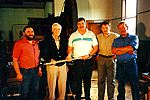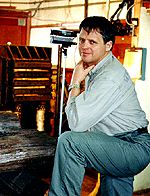
Alaska Frontier Archery (A.F.A) was created by its' founder Jack Harrison in 1994. A long time bowhunter and outdoorsman, Jack has always had an interest in building bows and began developing ideas on a two piece takedown longbow 12 yrs. ago. From these years of research and development, as well as help from a grant from the Alaska Science and Technology Foundation, Alaska Frontier Archery began, offering the Black Wolf and Siberian Wolf two piece takedown longbows.
To compliment his innovative bow design, Harrison also longed to bring back the Forgewood Arrow, considered by most as 'the best' wooden arrow ever made and so began the search for the original Forgewood equipment.
 Forgewood Arrows were a creation of Bill Sweetland (See article written in 1966) and in production for over 15 yrs. Sweetland sold his process and equipment to Phil Lieski and later with Don Brown started Don Brown Archery (See article). Through talks with Bill Sweetland, the Forgewood machinery was located in Centralia, Wash. in an old church building, still in running condition. (Photo with Phil Liske, Bill Sweetland, Stuart Smith, Jack Harrison and Steve Tanner)
Forgewood Arrows were a creation of Bill Sweetland (See article written in 1966) and in production for over 15 yrs. Sweetland sold his process and equipment to Phil Lieski and later with Don Brown started Don Brown Archery (See article). Through talks with Bill Sweetland, the Forgewood machinery was located in Centralia, Wash. in an old church building, still in running condition. (Photo with Phil Liske, Bill Sweetland, Stuart Smith, Jack Harrison and Steve Tanner)
In 1995, those of us from A.F.A (Jack Harrison, Stuart Smith, Steve Tanner) met with Phil Liske in Centralia to run the equipment and be instructed on the process, in consideration of its' purchase. Bill Sweetland also agreed to be present since he had not seen his Forgewood equipment for many years and was curious to see it run again.
Alaska Frontier Archery purchased the Forgewood equipment and all rights to the process in 1995 and moved it to Alaska where it now resides. Over the last several years , with the help of another grant from the State of Alaska's Science and Technology Foundation, all the original machinery has been restored and much research with various Alaskan native woods (Sitka Spruce, Mtn. Hemlock, Yellow Cedar, Alaskan Poplar) have been experimented with.
(Jack Harrison)
A.F.A 's arrow division is located in Nikiski, Alaska, just south of Anchorage on the Kenai Peninsula, and is owned and operated by Steve Tanner. Jack Harrison has 'Harrison Longbows' in Wasila, Alaska where he makes his high quality line of longbows.
(Jack Harrison and Bill Sweetland)

Smaller Diameter / Because our shafts have a very high cross sectional density, we are able to dowel them at a much smaller diameter than the standard arrow shaft and still maintain the proper spine and weight necessary for a premium hunting arrow. Small diameter also means higher velocity. With less displacement because of the smaller diameter, Forgewood Arrows cast surprisingly well and will compete with any other shafting on the market.
Higher Weight per Shaft / Inertia plays an important role in the trajectory of any arrow. Forgewood Arrows retain more inertia than many other types of wood shafting because there is more mass/unit volume that absorbs more of the stored energy from the bow limbs when shot. Because of the added weight, initial acceleration will be less, but, terminal acceleration, down range, will be higher with higher penetration potential.
Lower Natural Frequency / Through investigation with ballistics and penetration testing, it was discovered that the lower the natural frequency is of a shaft the slower it reacts to changes in acceleration and deceleration. In other words, when a shaft is shot from a bow, the slower it reacts to paradox the better. This is simply because the shock wave that travels down the shaft when the arrow is released is slower in Forgewood than aluminum or many other types of wood shafts. (High frequency arrows flirt more, while low frequency arrows flirt less.) With less paradox there is less resistance and drag on the arrow. Of course, drag interferes with velocity.
Durability and Toughness / Forgewoods are extremely tough, we have shot our arrows with no point, into a piece of 3/4 inch plywood, over and over, without them breaking. In the field, this accounts for longer arrow life, a shot into a bone or a miss into a rock will assure you of less broken shafts.